Organizational Change Management: HMRC Case Study Analysis Report
VerifiedAdded on 2020/03/02
|16
|4746
|38
Report
AI Summary
This report analyzes the management of change within Her Majesty's Revenue and Customs (HMRC), examining the organizational transformation that occurred following the merger of Inland Revenue and Her Majesty’s Customs and Excise. It explores the challenges faced, including integrating two distinct cultures and the implementation of the Pacesetter program, a lean management initiative. The report utilizes objectivist and social constructivist perspectives to assess the change, highlighting the importance of communication and employee understanding. A SWOT analysis is presented, evaluating the strengths, weaknesses, opportunities, and threats associated with the change. The report concludes by discussing the benefits and drawbacks of using SWOT analysis, considering both objectivist and social constructionist viewpoints, while emphasizing the impact of change on HMRC's operations and its diverse customer base. The document aims to provide a comprehensive understanding of the change management process within a large public sector organization.
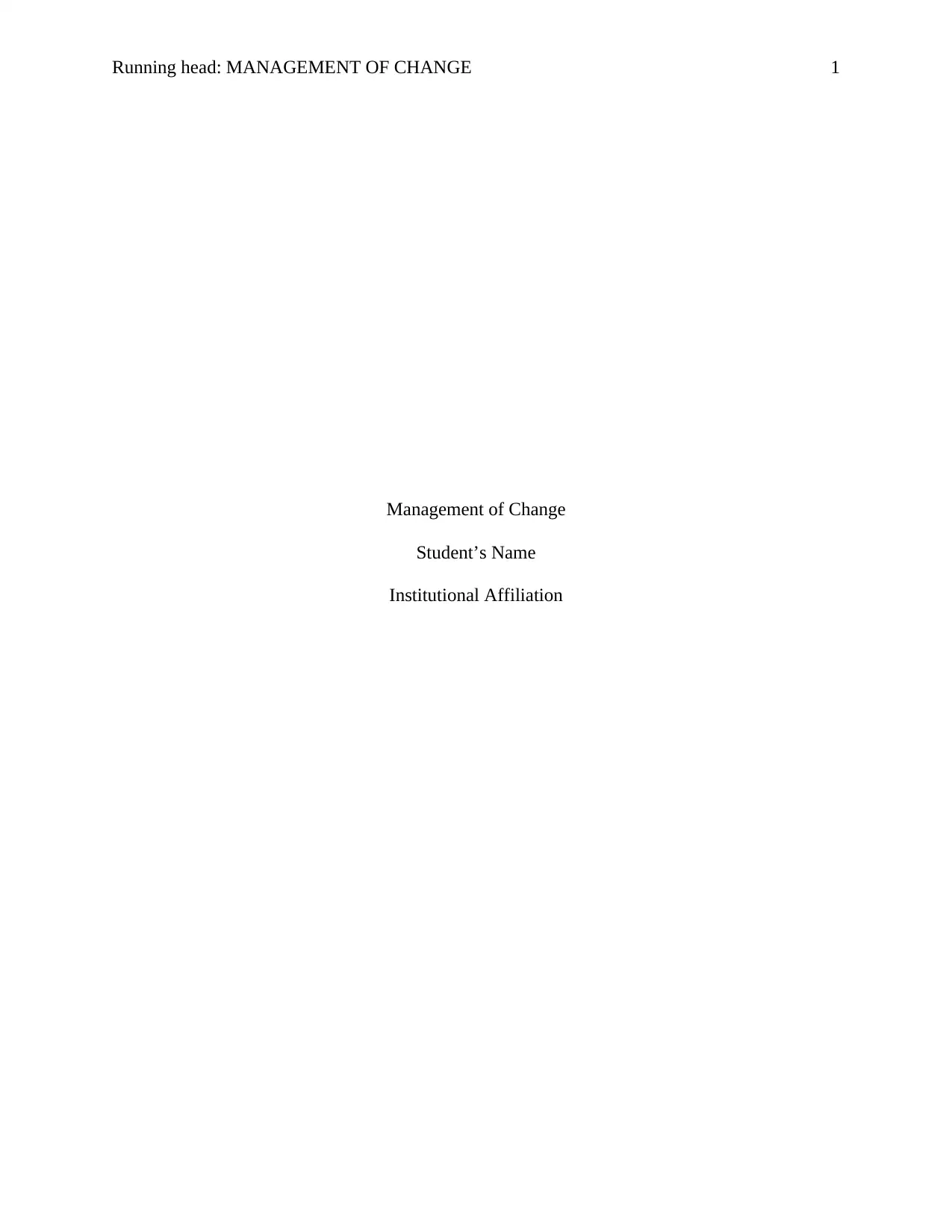
Running head: MANAGEMENT OF CHANGE 1
Management of Change
Student’s Name
Institutional Affiliation
Management of Change
Student’s Name
Institutional Affiliation
Paraphrase This Document
Need a fresh take? Get an instant paraphrase of this document with our AI Paraphraser
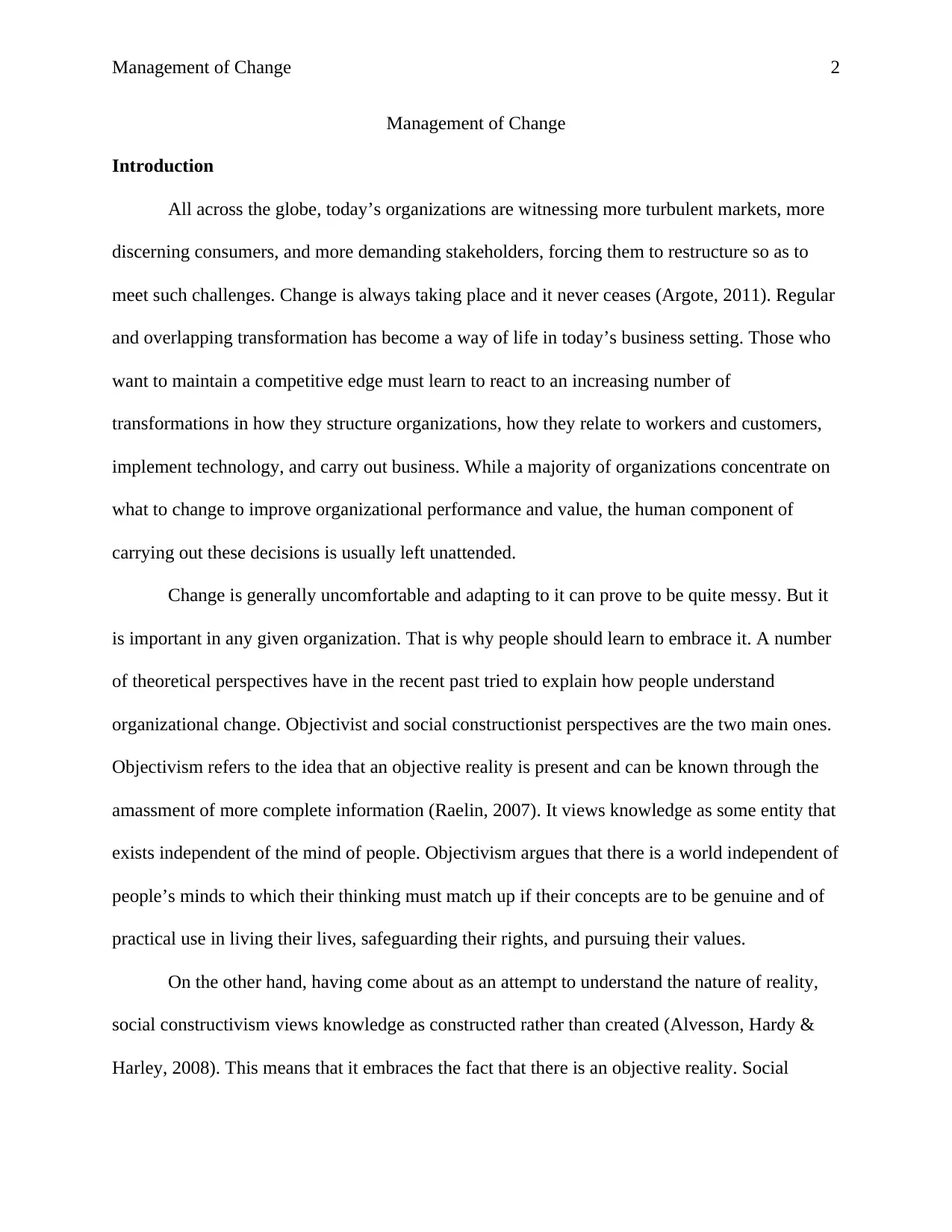
Management of Change 2
Management of Change
Introduction
All across the globe, today’s organizations are witnessing more turbulent markets, more
discerning consumers, and more demanding stakeholders, forcing them to restructure so as to
meet such challenges. Change is always taking place and it never ceases (Argote, 2011). Regular
and overlapping transformation has become a way of life in today’s business setting. Those who
want to maintain a competitive edge must learn to react to an increasing number of
transformations in how they structure organizations, how they relate to workers and customers,
implement technology, and carry out business. While a majority of organizations concentrate on
what to change to improve organizational performance and value, the human component of
carrying out these decisions is usually left unattended.
Change is generally uncomfortable and adapting to it can prove to be quite messy. But it
is important in any given organization. That is why people should learn to embrace it. A number
of theoretical perspectives have in the recent past tried to explain how people understand
organizational change. Objectivist and social constructionist perspectives are the two main ones.
Objectivism refers to the idea that an objective reality is present and can be known through the
amassment of more complete information (Raelin, 2007). It views knowledge as some entity that
exists independent of the mind of people. Objectivism argues that there is a world independent of
people’s minds to which their thinking must match up if their concepts are to be genuine and of
practical use in living their lives, safeguarding their rights, and pursuing their values.
On the other hand, having come about as an attempt to understand the nature of reality,
social constructivism views knowledge as constructed rather than created (Alvesson, Hardy &
Harley, 2008). This means that it embraces the fact that there is an objective reality. Social
Management of Change
Introduction
All across the globe, today’s organizations are witnessing more turbulent markets, more
discerning consumers, and more demanding stakeholders, forcing them to restructure so as to
meet such challenges. Change is always taking place and it never ceases (Argote, 2011). Regular
and overlapping transformation has become a way of life in today’s business setting. Those who
want to maintain a competitive edge must learn to react to an increasing number of
transformations in how they structure organizations, how they relate to workers and customers,
implement technology, and carry out business. While a majority of organizations concentrate on
what to change to improve organizational performance and value, the human component of
carrying out these decisions is usually left unattended.
Change is generally uncomfortable and adapting to it can prove to be quite messy. But it
is important in any given organization. That is why people should learn to embrace it. A number
of theoretical perspectives have in the recent past tried to explain how people understand
organizational change. Objectivist and social constructionist perspectives are the two main ones.
Objectivism refers to the idea that an objective reality is present and can be known through the
amassment of more complete information (Raelin, 2007). It views knowledge as some entity that
exists independent of the mind of people. Objectivism argues that there is a world independent of
people’s minds to which their thinking must match up if their concepts are to be genuine and of
practical use in living their lives, safeguarding their rights, and pursuing their values.
On the other hand, having come about as an attempt to understand the nature of reality,
social constructivism views knowledge as constructed rather than created (Alvesson, Hardy &
Harley, 2008). This means that it embraces the fact that there is an objective reality. Social
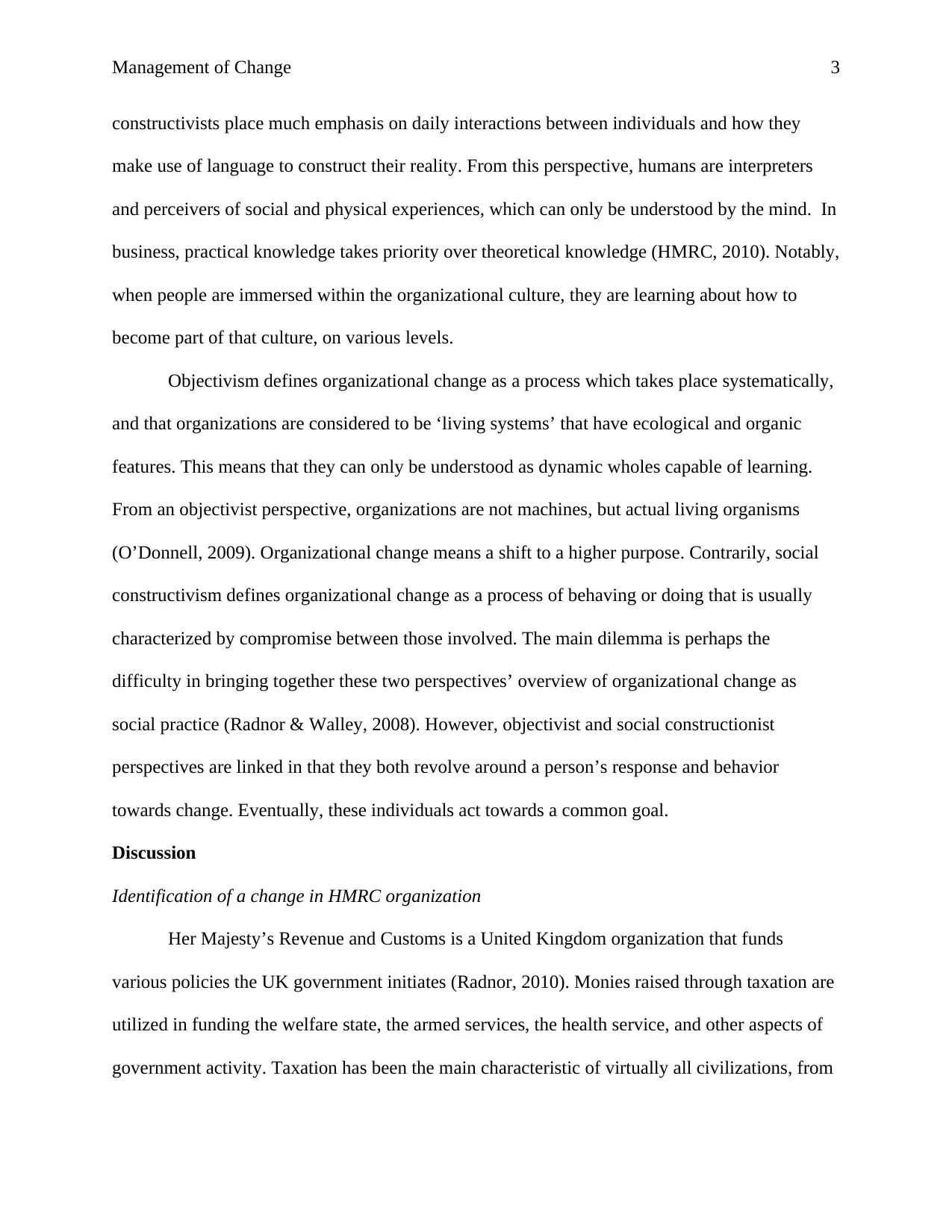
Management of Change 3
constructivists place much emphasis on daily interactions between individuals and how they
make use of language to construct their reality. From this perspective, humans are interpreters
and perceivers of social and physical experiences, which can only be understood by the mind. In
business, practical knowledge takes priority over theoretical knowledge (HMRC, 2010). Notably,
when people are immersed within the organizational culture, they are learning about how to
become part of that culture, on various levels.
Objectivism defines organizational change as a process which takes place systematically,
and that organizations are considered to be ‘living systems’ that have ecological and organic
features. This means that they can only be understood as dynamic wholes capable of learning.
From an objectivist perspective, organizations are not machines, but actual living organisms
(O’Donnell, 2009). Organizational change means a shift to a higher purpose. Contrarily, social
constructivism defines organizational change as a process of behaving or doing that is usually
characterized by compromise between those involved. The main dilemma is perhaps the
difficulty in bringing together these two perspectives’ overview of organizational change as
social practice (Radnor & Walley, 2008). However, objectivist and social constructionist
perspectives are linked in that they both revolve around a person’s response and behavior
towards change. Eventually, these individuals act towards a common goal.
Discussion
Identification of a change in HMRC organization
Her Majesty’s Revenue and Customs is a United Kingdom organization that funds
various policies the UK government initiates (Radnor, 2010). Monies raised through taxation are
utilized in funding the welfare state, the armed services, the health service, and other aspects of
government activity. Taxation has been the main characteristic of virtually all civilizations, from
constructivists place much emphasis on daily interactions between individuals and how they
make use of language to construct their reality. From this perspective, humans are interpreters
and perceivers of social and physical experiences, which can only be understood by the mind. In
business, practical knowledge takes priority over theoretical knowledge (HMRC, 2010). Notably,
when people are immersed within the organizational culture, they are learning about how to
become part of that culture, on various levels.
Objectivism defines organizational change as a process which takes place systematically,
and that organizations are considered to be ‘living systems’ that have ecological and organic
features. This means that they can only be understood as dynamic wholes capable of learning.
From an objectivist perspective, organizations are not machines, but actual living organisms
(O’Donnell, 2009). Organizational change means a shift to a higher purpose. Contrarily, social
constructivism defines organizational change as a process of behaving or doing that is usually
characterized by compromise between those involved. The main dilemma is perhaps the
difficulty in bringing together these two perspectives’ overview of organizational change as
social practice (Radnor & Walley, 2008). However, objectivist and social constructionist
perspectives are linked in that they both revolve around a person’s response and behavior
towards change. Eventually, these individuals act towards a common goal.
Discussion
Identification of a change in HMRC organization
Her Majesty’s Revenue and Customs is a United Kingdom organization that funds
various policies the UK government initiates (Radnor, 2010). Monies raised through taxation are
utilized in funding the welfare state, the armed services, the health service, and other aspects of
government activity. Taxation has been the main characteristic of virtually all civilizations, from
⊘ This is a preview!⊘
Do you want full access?
Subscribe today to unlock all pages.

Trusted by 1+ million students worldwide
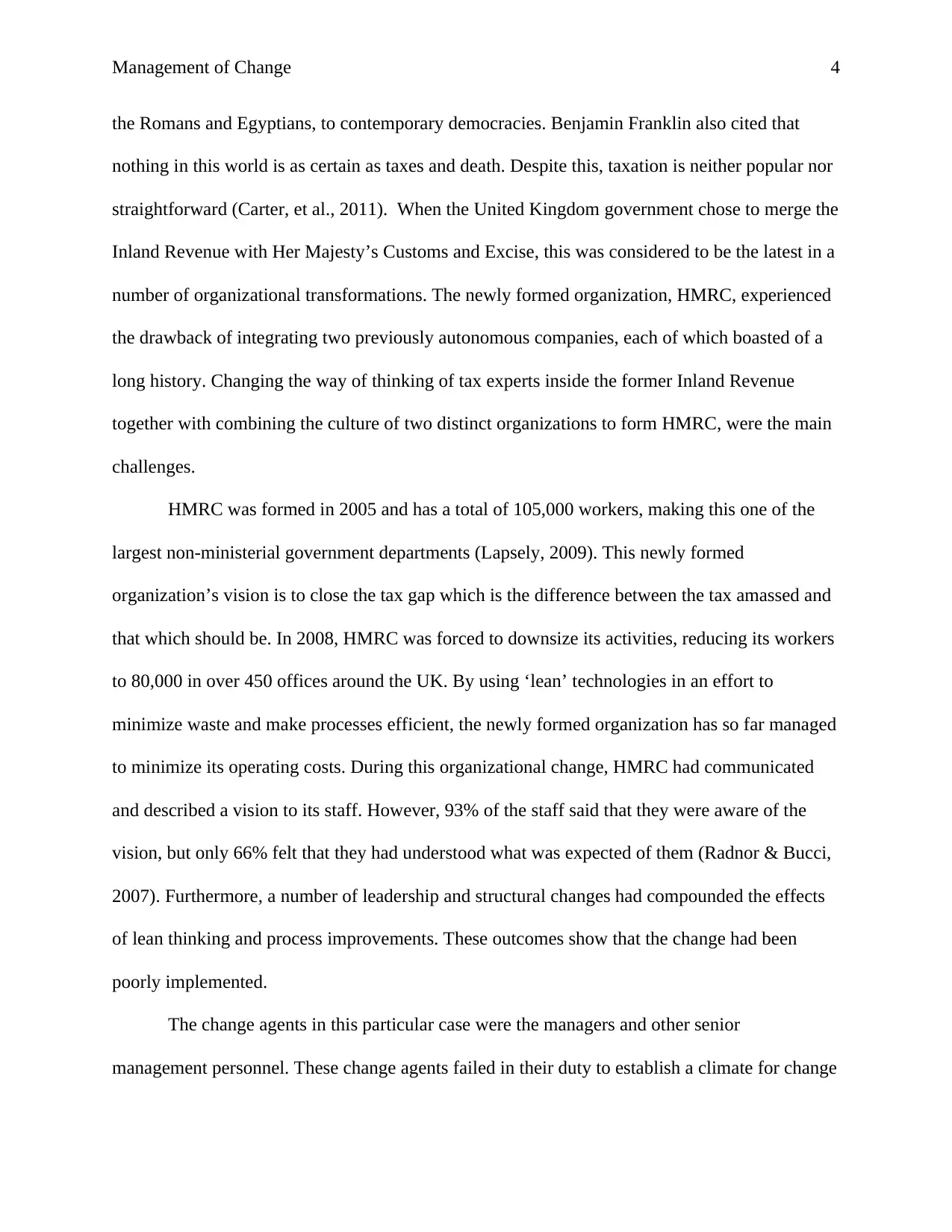
Management of Change 4
the Romans and Egyptians, to contemporary democracies. Benjamin Franklin also cited that
nothing in this world is as certain as taxes and death. Despite this, taxation is neither popular nor
straightforward (Carter, et al., 2011). When the United Kingdom government chose to merge the
Inland Revenue with Her Majesty’s Customs and Excise, this was considered to be the latest in a
number of organizational transformations. The newly formed organization, HMRC, experienced
the drawback of integrating two previously autonomous companies, each of which boasted of a
long history. Changing the way of thinking of tax experts inside the former Inland Revenue
together with combining the culture of two distinct organizations to form HMRC, were the main
challenges.
HMRC was formed in 2005 and has a total of 105,000 workers, making this one of the
largest non-ministerial government departments (Lapsely, 2009). This newly formed
organization’s vision is to close the tax gap which is the difference between the tax amassed and
that which should be. In 2008, HMRC was forced to downsize its activities, reducing its workers
to 80,000 in over 450 offices around the UK. By using ‘lean’ technologies in an effort to
minimize waste and make processes efficient, the newly formed organization has so far managed
to minimize its operating costs. During this organizational change, HMRC had communicated
and described a vision to its staff. However, 93% of the staff said that they were aware of the
vision, but only 66% felt that they had understood what was expected of them (Radnor & Bucci,
2007). Furthermore, a number of leadership and structural changes had compounded the effects
of lean thinking and process improvements. These outcomes show that the change had been
poorly implemented.
The change agents in this particular case were the managers and other senior
management personnel. These change agents failed in their duty to establish a climate for change
the Romans and Egyptians, to contemporary democracies. Benjamin Franklin also cited that
nothing in this world is as certain as taxes and death. Despite this, taxation is neither popular nor
straightforward (Carter, et al., 2011). When the United Kingdom government chose to merge the
Inland Revenue with Her Majesty’s Customs and Excise, this was considered to be the latest in a
number of organizational transformations. The newly formed organization, HMRC, experienced
the drawback of integrating two previously autonomous companies, each of which boasted of a
long history. Changing the way of thinking of tax experts inside the former Inland Revenue
together with combining the culture of two distinct organizations to form HMRC, were the main
challenges.
HMRC was formed in 2005 and has a total of 105,000 workers, making this one of the
largest non-ministerial government departments (Lapsely, 2009). This newly formed
organization’s vision is to close the tax gap which is the difference between the tax amassed and
that which should be. In 2008, HMRC was forced to downsize its activities, reducing its workers
to 80,000 in over 450 offices around the UK. By using ‘lean’ technologies in an effort to
minimize waste and make processes efficient, the newly formed organization has so far managed
to minimize its operating costs. During this organizational change, HMRC had communicated
and described a vision to its staff. However, 93% of the staff said that they were aware of the
vision, but only 66% felt that they had understood what was expected of them (Radnor & Bucci,
2007). Furthermore, a number of leadership and structural changes had compounded the effects
of lean thinking and process improvements. These outcomes show that the change had been
poorly implemented.
The change agents in this particular case were the managers and other senior
management personnel. These change agents failed in their duty to establish a climate for change
Paraphrase This Document
Need a fresh take? Get an instant paraphrase of this document with our AI Paraphraser
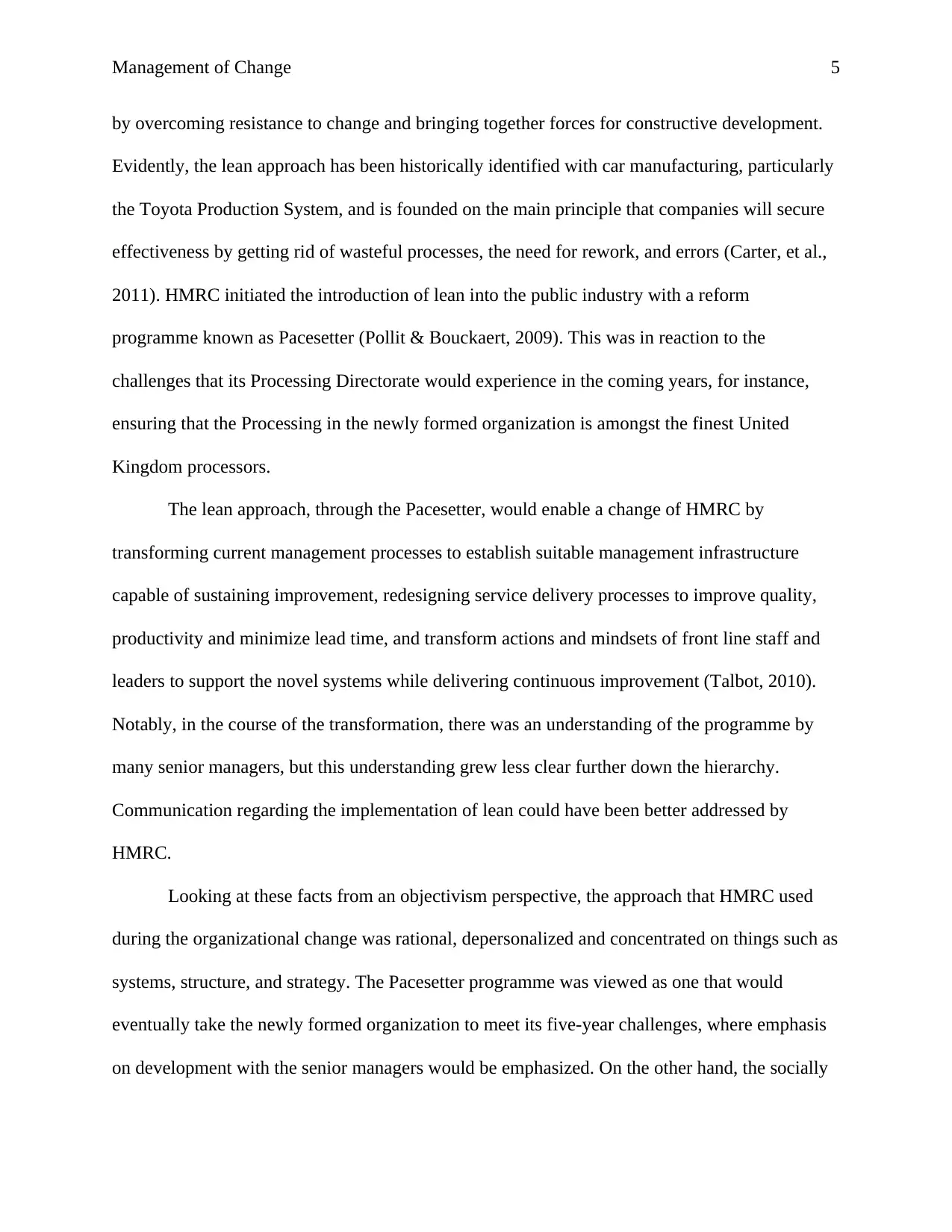
Management of Change 5
by overcoming resistance to change and bringing together forces for constructive development.
Evidently, the lean approach has been historically identified with car manufacturing, particularly
the Toyota Production System, and is founded on the main principle that companies will secure
effectiveness by getting rid of wasteful processes, the need for rework, and errors (Carter, et al.,
2011). HMRC initiated the introduction of lean into the public industry with a reform
programme known as Pacesetter (Pollit & Bouckaert, 2009). This was in reaction to the
challenges that its Processing Directorate would experience in the coming years, for instance,
ensuring that the Processing in the newly formed organization is amongst the finest United
Kingdom processors.
The lean approach, through the Pacesetter, would enable a change of HMRC by
transforming current management processes to establish suitable management infrastructure
capable of sustaining improvement, redesigning service delivery processes to improve quality,
productivity and minimize lead time, and transform actions and mindsets of front line staff and
leaders to support the novel systems while delivering continuous improvement (Talbot, 2010).
Notably, in the course of the transformation, there was an understanding of the programme by
many senior managers, but this understanding grew less clear further down the hierarchy.
Communication regarding the implementation of lean could have been better addressed by
HMRC.
Looking at these facts from an objectivism perspective, the approach that HMRC used
during the organizational change was rational, depersonalized and concentrated on things such as
systems, structure, and strategy. The Pacesetter programme was viewed as one that would
eventually take the newly formed organization to meet its five-year challenges, where emphasis
on development with the senior managers would be emphasized. On the other hand, the socially
by overcoming resistance to change and bringing together forces for constructive development.
Evidently, the lean approach has been historically identified with car manufacturing, particularly
the Toyota Production System, and is founded on the main principle that companies will secure
effectiveness by getting rid of wasteful processes, the need for rework, and errors (Carter, et al.,
2011). HMRC initiated the introduction of lean into the public industry with a reform
programme known as Pacesetter (Pollit & Bouckaert, 2009). This was in reaction to the
challenges that its Processing Directorate would experience in the coming years, for instance,
ensuring that the Processing in the newly formed organization is amongst the finest United
Kingdom processors.
The lean approach, through the Pacesetter, would enable a change of HMRC by
transforming current management processes to establish suitable management infrastructure
capable of sustaining improvement, redesigning service delivery processes to improve quality,
productivity and minimize lead time, and transform actions and mindsets of front line staff and
leaders to support the novel systems while delivering continuous improvement (Talbot, 2010).
Notably, in the course of the transformation, there was an understanding of the programme by
many senior managers, but this understanding grew less clear further down the hierarchy.
Communication regarding the implementation of lean could have been better addressed by
HMRC.
Looking at these facts from an objectivism perspective, the approach that HMRC used
during the organizational change was rational, depersonalized and concentrated on things such as
systems, structure, and strategy. The Pacesetter programme was viewed as one that would
eventually take the newly formed organization to meet its five-year challenges, where emphasis
on development with the senior managers would be emphasized. On the other hand, the socially
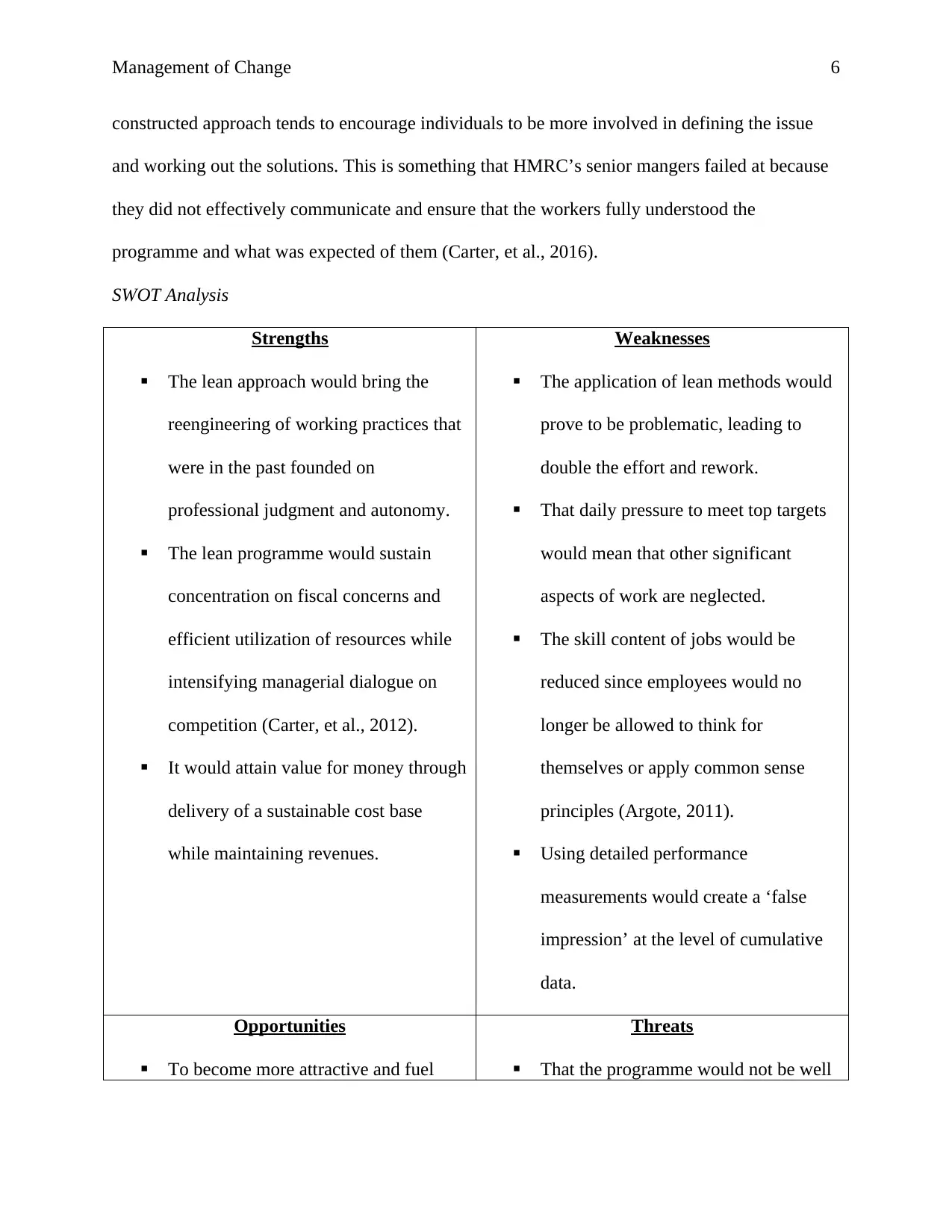
Management of Change 6
constructed approach tends to encourage individuals to be more involved in defining the issue
and working out the solutions. This is something that HMRC’s senior mangers failed at because
they did not effectively communicate and ensure that the workers fully understood the
programme and what was expected of them (Carter, et al., 2016).
SWOT Analysis
Strengths
The lean approach would bring the
reengineering of working practices that
were in the past founded on
professional judgment and autonomy.
The lean programme would sustain
concentration on fiscal concerns and
efficient utilization of resources while
intensifying managerial dialogue on
competition (Carter, et al., 2012).
It would attain value for money through
delivery of a sustainable cost base
while maintaining revenues.
Weaknesses
The application of lean methods would
prove to be problematic, leading to
double the effort and rework.
That daily pressure to meet top targets
would mean that other significant
aspects of work are neglected.
The skill content of jobs would be
reduced since employees would no
longer be allowed to think for
themselves or apply common sense
principles (Argote, 2011).
Using detailed performance
measurements would create a ‘false
impression’ at the level of cumulative
data.
Opportunities
To become more attractive and fuel
Threats
That the programme would not be well
constructed approach tends to encourage individuals to be more involved in defining the issue
and working out the solutions. This is something that HMRC’s senior mangers failed at because
they did not effectively communicate and ensure that the workers fully understood the
programme and what was expected of them (Carter, et al., 2016).
SWOT Analysis
Strengths
The lean approach would bring the
reengineering of working practices that
were in the past founded on
professional judgment and autonomy.
The lean programme would sustain
concentration on fiscal concerns and
efficient utilization of resources while
intensifying managerial dialogue on
competition (Carter, et al., 2012).
It would attain value for money through
delivery of a sustainable cost base
while maintaining revenues.
Weaknesses
The application of lean methods would
prove to be problematic, leading to
double the effort and rework.
That daily pressure to meet top targets
would mean that other significant
aspects of work are neglected.
The skill content of jobs would be
reduced since employees would no
longer be allowed to think for
themselves or apply common sense
principles (Argote, 2011).
Using detailed performance
measurements would create a ‘false
impression’ at the level of cumulative
data.
Opportunities
To become more attractive and fuel
Threats
That the programme would not be well
⊘ This is a preview!⊘
Do you want full access?
Subscribe today to unlock all pages.

Trusted by 1+ million students worldwide
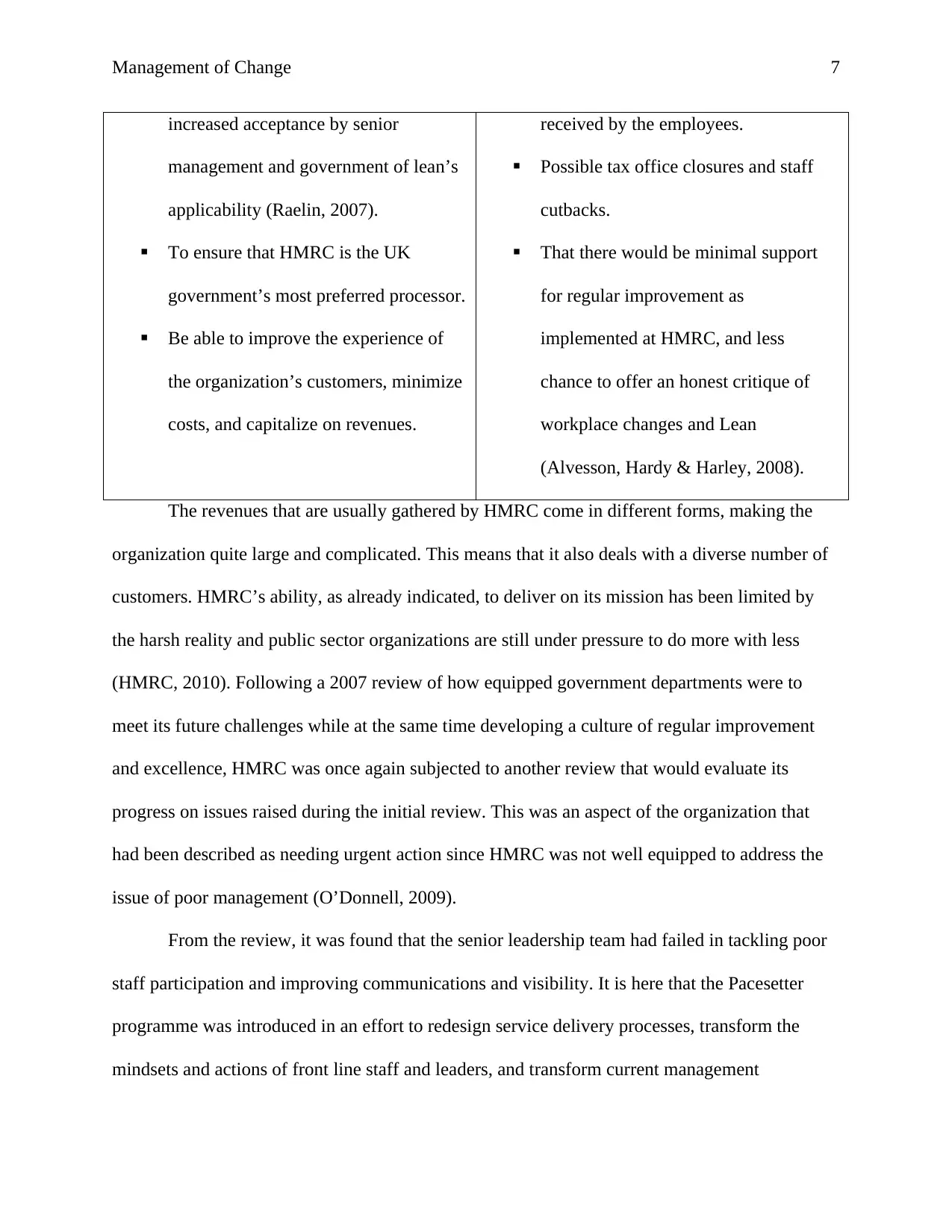
Management of Change 7
increased acceptance by senior
management and government of lean’s
applicability (Raelin, 2007).
To ensure that HMRC is the UK
government’s most preferred processor.
Be able to improve the experience of
the organization’s customers, minimize
costs, and capitalize on revenues.
received by the employees.
Possible tax office closures and staff
cutbacks.
That there would be minimal support
for regular improvement as
implemented at HMRC, and less
chance to offer an honest critique of
workplace changes and Lean
(Alvesson, Hardy & Harley, 2008).
The revenues that are usually gathered by HMRC come in different forms, making the
organization quite large and complicated. This means that it also deals with a diverse number of
customers. HMRC’s ability, as already indicated, to deliver on its mission has been limited by
the harsh reality and public sector organizations are still under pressure to do more with less
(HMRC, 2010). Following a 2007 review of how equipped government departments were to
meet its future challenges while at the same time developing a culture of regular improvement
and excellence, HMRC was once again subjected to another review that would evaluate its
progress on issues raised during the initial review. This was an aspect of the organization that
had been described as needing urgent action since HMRC was not well equipped to address the
issue of poor management (O’Donnell, 2009).
From the review, it was found that the senior leadership team had failed in tackling poor
staff participation and improving communications and visibility. It is here that the Pacesetter
programme was introduced in an effort to redesign service delivery processes, transform the
mindsets and actions of front line staff and leaders, and transform current management
increased acceptance by senior
management and government of lean’s
applicability (Raelin, 2007).
To ensure that HMRC is the UK
government’s most preferred processor.
Be able to improve the experience of
the organization’s customers, minimize
costs, and capitalize on revenues.
received by the employees.
Possible tax office closures and staff
cutbacks.
That there would be minimal support
for regular improvement as
implemented at HMRC, and less
chance to offer an honest critique of
workplace changes and Lean
(Alvesson, Hardy & Harley, 2008).
The revenues that are usually gathered by HMRC come in different forms, making the
organization quite large and complicated. This means that it also deals with a diverse number of
customers. HMRC’s ability, as already indicated, to deliver on its mission has been limited by
the harsh reality and public sector organizations are still under pressure to do more with less
(HMRC, 2010). Following a 2007 review of how equipped government departments were to
meet its future challenges while at the same time developing a culture of regular improvement
and excellence, HMRC was once again subjected to another review that would evaluate its
progress on issues raised during the initial review. This was an aspect of the organization that
had been described as needing urgent action since HMRC was not well equipped to address the
issue of poor management (O’Donnell, 2009).
From the review, it was found that the senior leadership team had failed in tackling poor
staff participation and improving communications and visibility. It is here that the Pacesetter
programme was introduced in an effort to redesign service delivery processes, transform the
mindsets and actions of front line staff and leaders, and transform current management
Paraphrase This Document
Need a fresh take? Get an instant paraphrase of this document with our AI Paraphraser
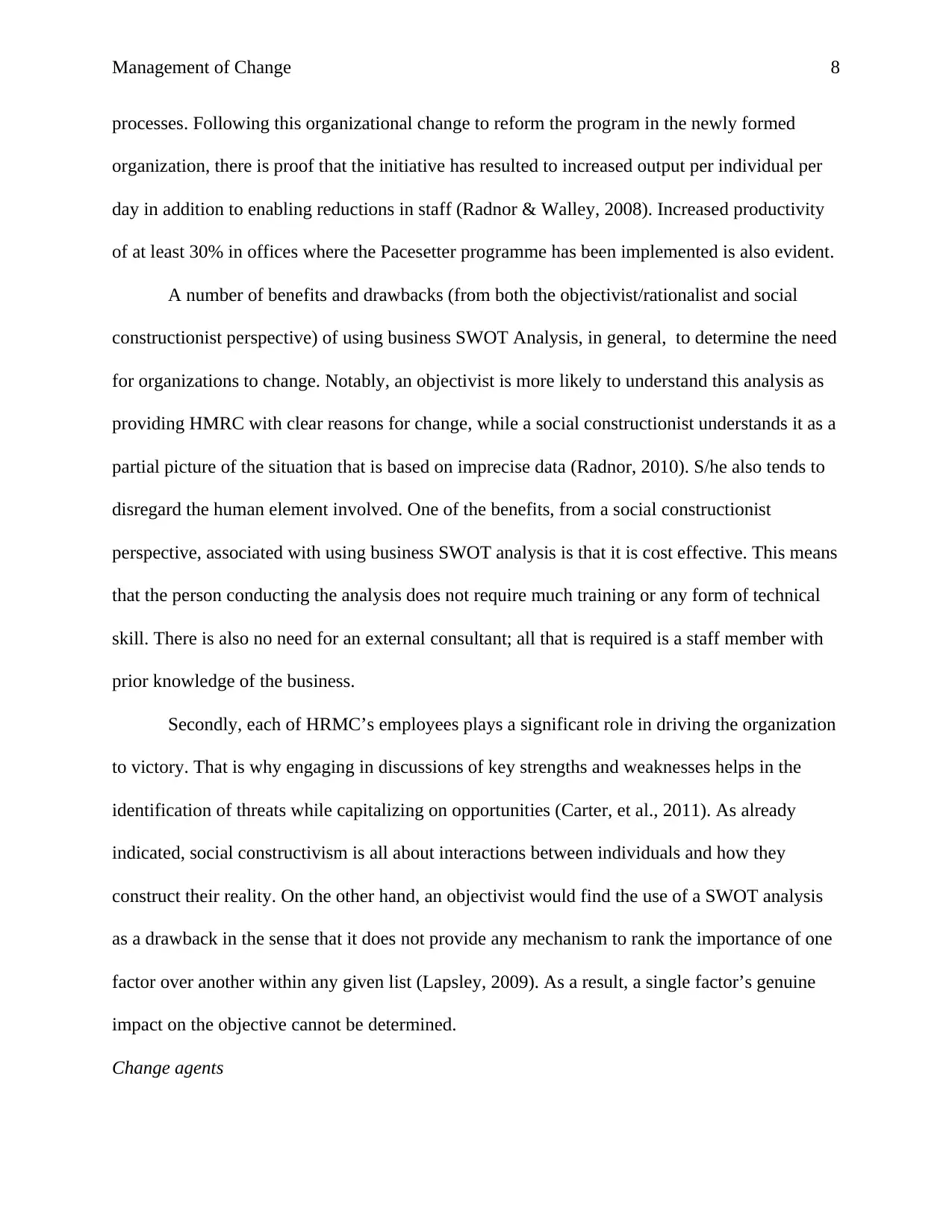
Management of Change 8
processes. Following this organizational change to reform the program in the newly formed
organization, there is proof that the initiative has resulted to increased output per individual per
day in addition to enabling reductions in staff (Radnor & Walley, 2008). Increased productivity
of at least 30% in offices where the Pacesetter programme has been implemented is also evident.
A number of benefits and drawbacks (from both the objectivist/rationalist and social
constructionist perspective) of using business SWOT Analysis, in general, to determine the need
for organizations to change. Notably, an objectivist is more likely to understand this analysis as
providing HMRC with clear reasons for change, while a social constructionist understands it as a
partial picture of the situation that is based on imprecise data (Radnor, 2010). S/he also tends to
disregard the human element involved. One of the benefits, from a social constructionist
perspective, associated with using business SWOT analysis is that it is cost effective. This means
that the person conducting the analysis does not require much training or any form of technical
skill. There is also no need for an external consultant; all that is required is a staff member with
prior knowledge of the business.
Secondly, each of HRMC’s employees plays a significant role in driving the organization
to victory. That is why engaging in discussions of key strengths and weaknesses helps in the
identification of threats while capitalizing on opportunities (Carter, et al., 2011). As already
indicated, social constructivism is all about interactions between individuals and how they
construct their reality. On the other hand, an objectivist would find the use of a SWOT analysis
as a drawback in the sense that it does not provide any mechanism to rank the importance of one
factor over another within any given list (Lapsley, 2009). As a result, a single factor’s genuine
impact on the objective cannot be determined.
Change agents
processes. Following this organizational change to reform the program in the newly formed
organization, there is proof that the initiative has resulted to increased output per individual per
day in addition to enabling reductions in staff (Radnor & Walley, 2008). Increased productivity
of at least 30% in offices where the Pacesetter programme has been implemented is also evident.
A number of benefits and drawbacks (from both the objectivist/rationalist and social
constructionist perspective) of using business SWOT Analysis, in general, to determine the need
for organizations to change. Notably, an objectivist is more likely to understand this analysis as
providing HMRC with clear reasons for change, while a social constructionist understands it as a
partial picture of the situation that is based on imprecise data (Radnor, 2010). S/he also tends to
disregard the human element involved. One of the benefits, from a social constructionist
perspective, associated with using business SWOT analysis is that it is cost effective. This means
that the person conducting the analysis does not require much training or any form of technical
skill. There is also no need for an external consultant; all that is required is a staff member with
prior knowledge of the business.
Secondly, each of HRMC’s employees plays a significant role in driving the organization
to victory. That is why engaging in discussions of key strengths and weaknesses helps in the
identification of threats while capitalizing on opportunities (Carter, et al., 2011). As already
indicated, social constructivism is all about interactions between individuals and how they
construct their reality. On the other hand, an objectivist would find the use of a SWOT analysis
as a drawback in the sense that it does not provide any mechanism to rank the importance of one
factor over another within any given list (Lapsley, 2009). As a result, a single factor’s genuine
impact on the objective cannot be determined.
Change agents
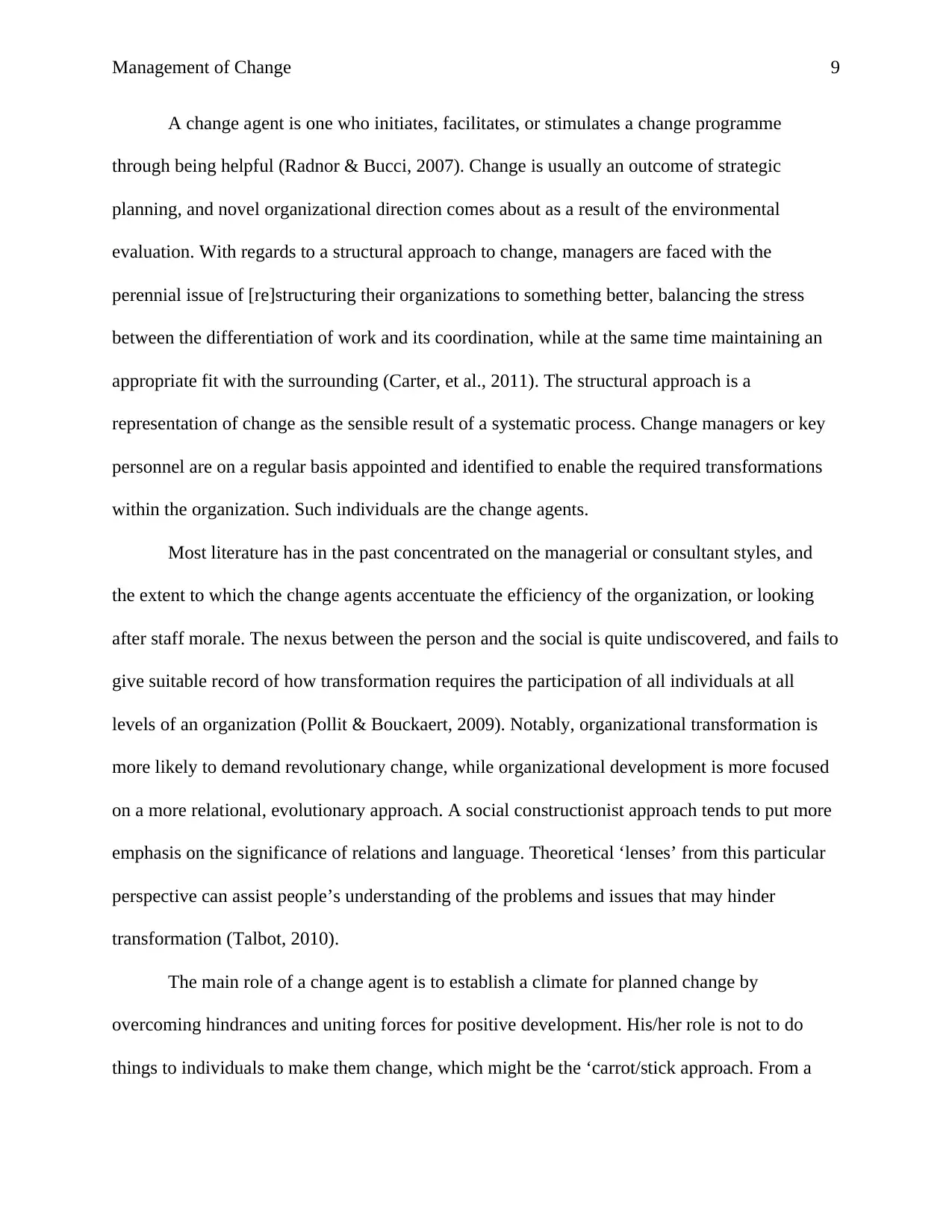
Management of Change 9
A change agent is one who initiates, facilitates, or stimulates a change programme
through being helpful (Radnor & Bucci, 2007). Change is usually an outcome of strategic
planning, and novel organizational direction comes about as a result of the environmental
evaluation. With regards to a structural approach to change, managers are faced with the
perennial issue of [re]structuring their organizations to something better, balancing the stress
between the differentiation of work and its coordination, while at the same time maintaining an
appropriate fit with the surrounding (Carter, et al., 2011). The structural approach is a
representation of change as the sensible result of a systematic process. Change managers or key
personnel are on a regular basis appointed and identified to enable the required transformations
within the organization. Such individuals are the change agents.
Most literature has in the past concentrated on the managerial or consultant styles, and
the extent to which the change agents accentuate the efficiency of the organization, or looking
after staff morale. The nexus between the person and the social is quite undiscovered, and fails to
give suitable record of how transformation requires the participation of all individuals at all
levels of an organization (Pollit & Bouckaert, 2009). Notably, organizational transformation is
more likely to demand revolutionary change, while organizational development is more focused
on a more relational, evolutionary approach. A social constructionist approach tends to put more
emphasis on the significance of relations and language. Theoretical ‘lenses’ from this particular
perspective can assist people’s understanding of the problems and issues that may hinder
transformation (Talbot, 2010).
The main role of a change agent is to establish a climate for planned change by
overcoming hindrances and uniting forces for positive development. His/her role is not to do
things to individuals to make them change, which might be the ‘carrot/stick approach. From a
A change agent is one who initiates, facilitates, or stimulates a change programme
through being helpful (Radnor & Bucci, 2007). Change is usually an outcome of strategic
planning, and novel organizational direction comes about as a result of the environmental
evaluation. With regards to a structural approach to change, managers are faced with the
perennial issue of [re]structuring their organizations to something better, balancing the stress
between the differentiation of work and its coordination, while at the same time maintaining an
appropriate fit with the surrounding (Carter, et al., 2011). The structural approach is a
representation of change as the sensible result of a systematic process. Change managers or key
personnel are on a regular basis appointed and identified to enable the required transformations
within the organization. Such individuals are the change agents.
Most literature has in the past concentrated on the managerial or consultant styles, and
the extent to which the change agents accentuate the efficiency of the organization, or looking
after staff morale. The nexus between the person and the social is quite undiscovered, and fails to
give suitable record of how transformation requires the participation of all individuals at all
levels of an organization (Pollit & Bouckaert, 2009). Notably, organizational transformation is
more likely to demand revolutionary change, while organizational development is more focused
on a more relational, evolutionary approach. A social constructionist approach tends to put more
emphasis on the significance of relations and language. Theoretical ‘lenses’ from this particular
perspective can assist people’s understanding of the problems and issues that may hinder
transformation (Talbot, 2010).
The main role of a change agent is to establish a climate for planned change by
overcoming hindrances and uniting forces for positive development. His/her role is not to do
things to individuals to make them change, which might be the ‘carrot/stick approach. From a
⊘ This is a preview!⊘
Do you want full access?
Subscribe today to unlock all pages.

Trusted by 1+ million students worldwide
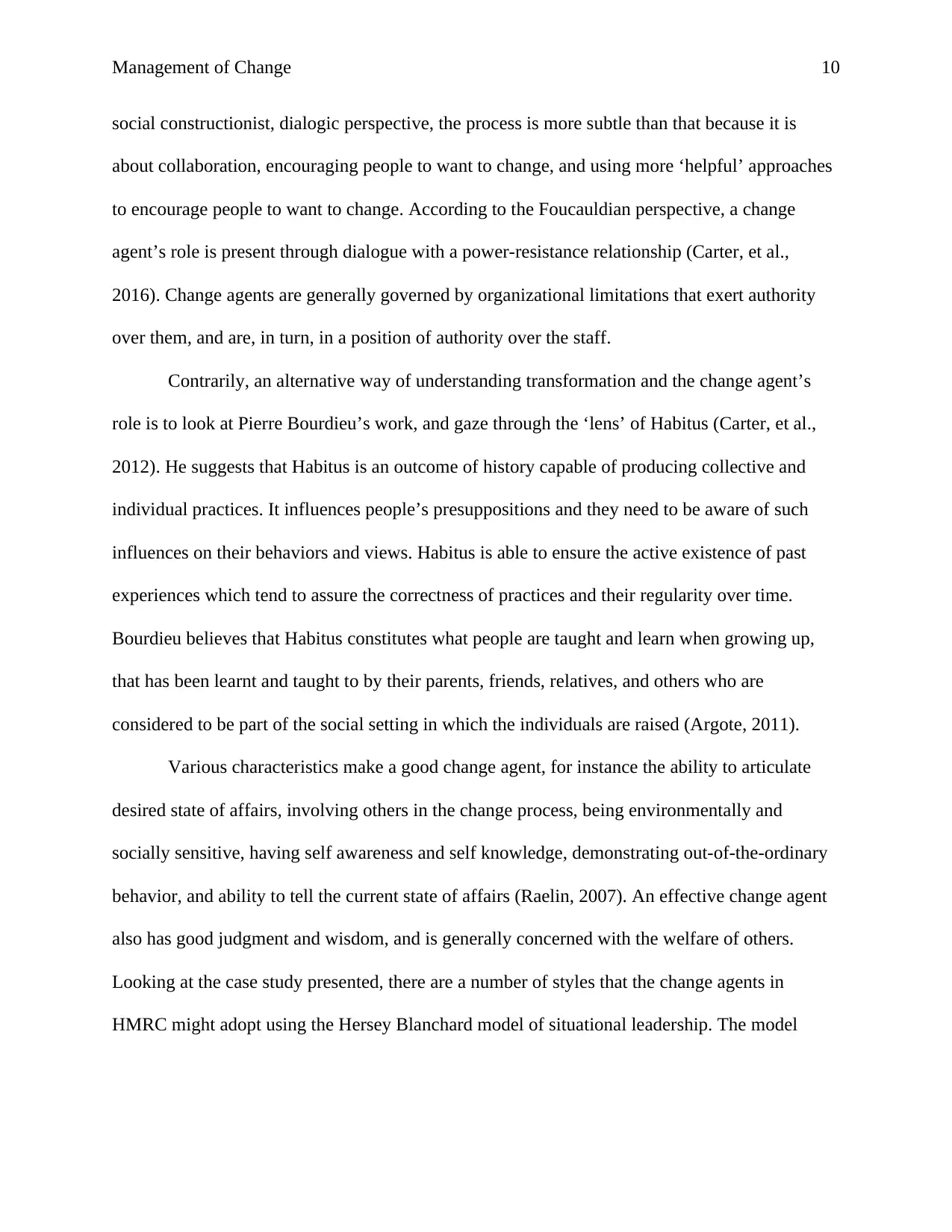
Management of Change 10
social constructionist, dialogic perspective, the process is more subtle than that because it is
about collaboration, encouraging people to want to change, and using more ‘helpful’ approaches
to encourage people to want to change. According to the Foucauldian perspective, a change
agent’s role is present through dialogue with a power-resistance relationship (Carter, et al.,
2016). Change agents are generally governed by organizational limitations that exert authority
over them, and are, in turn, in a position of authority over the staff.
Contrarily, an alternative way of understanding transformation and the change agent’s
role is to look at Pierre Bourdieu’s work, and gaze through the ‘lens’ of Habitus (Carter, et al.,
2012). He suggests that Habitus is an outcome of history capable of producing collective and
individual practices. It influences people’s presuppositions and they need to be aware of such
influences on their behaviors and views. Habitus is able to ensure the active existence of past
experiences which tend to assure the correctness of practices and their regularity over time.
Bourdieu believes that Habitus constitutes what people are taught and learn when growing up,
that has been learnt and taught to by their parents, friends, relatives, and others who are
considered to be part of the social setting in which the individuals are raised (Argote, 2011).
Various characteristics make a good change agent, for instance the ability to articulate
desired state of affairs, involving others in the change process, being environmentally and
socially sensitive, having self awareness and self knowledge, demonstrating out-of-the-ordinary
behavior, and ability to tell the current state of affairs (Raelin, 2007). An effective change agent
also has good judgment and wisdom, and is generally concerned with the welfare of others.
Looking at the case study presented, there are a number of styles that the change agents in
HMRC might adopt using the Hersey Blanchard model of situational leadership. The model
social constructionist, dialogic perspective, the process is more subtle than that because it is
about collaboration, encouraging people to want to change, and using more ‘helpful’ approaches
to encourage people to want to change. According to the Foucauldian perspective, a change
agent’s role is present through dialogue with a power-resistance relationship (Carter, et al.,
2016). Change agents are generally governed by organizational limitations that exert authority
over them, and are, in turn, in a position of authority over the staff.
Contrarily, an alternative way of understanding transformation and the change agent’s
role is to look at Pierre Bourdieu’s work, and gaze through the ‘lens’ of Habitus (Carter, et al.,
2012). He suggests that Habitus is an outcome of history capable of producing collective and
individual practices. It influences people’s presuppositions and they need to be aware of such
influences on their behaviors and views. Habitus is able to ensure the active existence of past
experiences which tend to assure the correctness of practices and their regularity over time.
Bourdieu believes that Habitus constitutes what people are taught and learn when growing up,
that has been learnt and taught to by their parents, friends, relatives, and others who are
considered to be part of the social setting in which the individuals are raised (Argote, 2011).
Various characteristics make a good change agent, for instance the ability to articulate
desired state of affairs, involving others in the change process, being environmentally and
socially sensitive, having self awareness and self knowledge, demonstrating out-of-the-ordinary
behavior, and ability to tell the current state of affairs (Raelin, 2007). An effective change agent
also has good judgment and wisdom, and is generally concerned with the welfare of others.
Looking at the case study presented, there are a number of styles that the change agents in
HMRC might adopt using the Hersey Blanchard model of situational leadership. The model
Paraphrase This Document
Need a fresh take? Get an instant paraphrase of this document with our AI Paraphraser
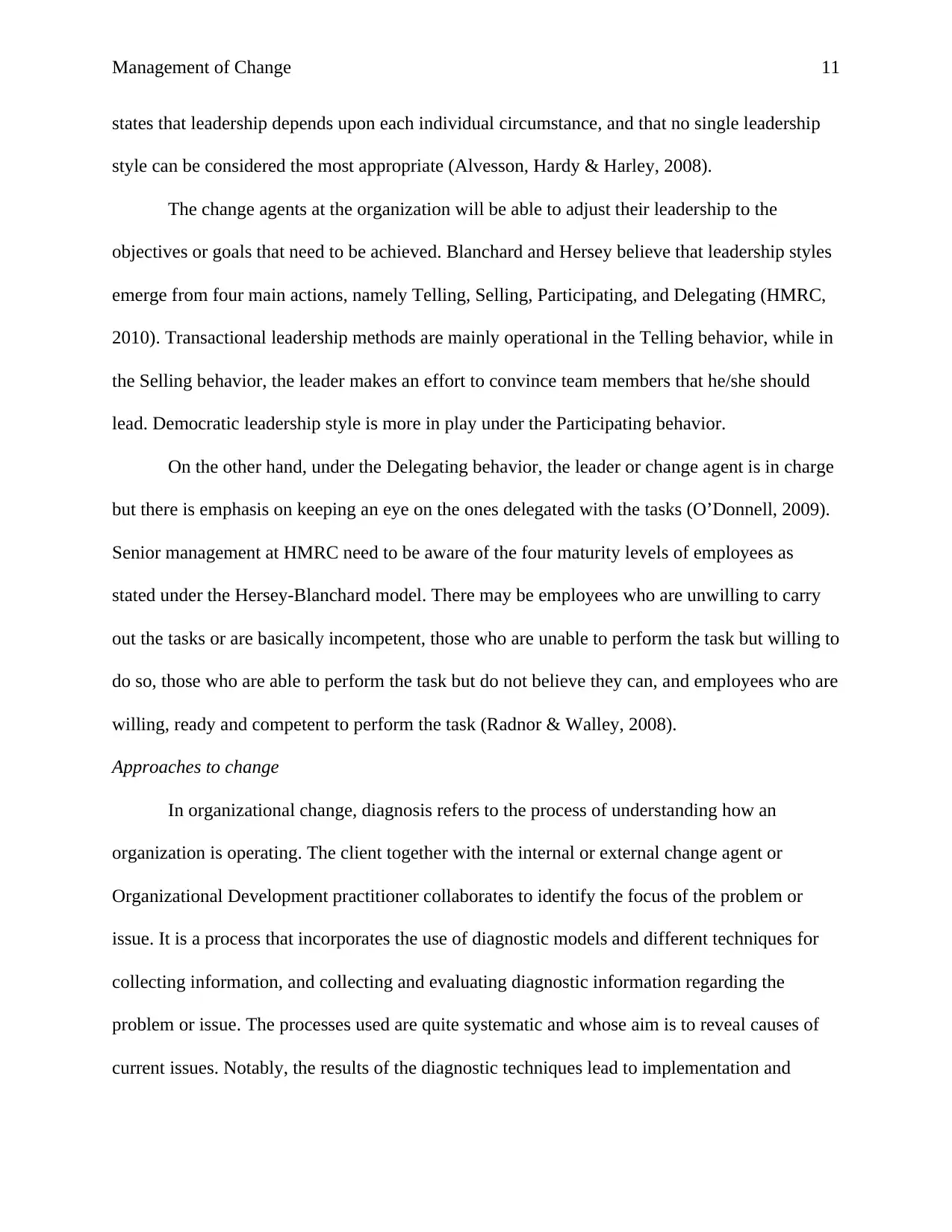
Management of Change 11
states that leadership depends upon each individual circumstance, and that no single leadership
style can be considered the most appropriate (Alvesson, Hardy & Harley, 2008).
The change agents at the organization will be able to adjust their leadership to the
objectives or goals that need to be achieved. Blanchard and Hersey believe that leadership styles
emerge from four main actions, namely Telling, Selling, Participating, and Delegating (HMRC,
2010). Transactional leadership methods are mainly operational in the Telling behavior, while in
the Selling behavior, the leader makes an effort to convince team members that he/she should
lead. Democratic leadership style is more in play under the Participating behavior.
On the other hand, under the Delegating behavior, the leader or change agent is in charge
but there is emphasis on keeping an eye on the ones delegated with the tasks (O’Donnell, 2009).
Senior management at HMRC need to be aware of the four maturity levels of employees as
stated under the Hersey-Blanchard model. There may be employees who are unwilling to carry
out the tasks or are basically incompetent, those who are unable to perform the task but willing to
do so, those who are able to perform the task but do not believe they can, and employees who are
willing, ready and competent to perform the task (Radnor & Walley, 2008).
Approaches to change
In organizational change, diagnosis refers to the process of understanding how an
organization is operating. The client together with the internal or external change agent or
Organizational Development practitioner collaborates to identify the focus of the problem or
issue. It is a process that incorporates the use of diagnostic models and different techniques for
collecting information, and collecting and evaluating diagnostic information regarding the
problem or issue. The processes used are quite systematic and whose aim is to reveal causes of
current issues. Notably, the results of the diagnostic techniques lead to implementation and
states that leadership depends upon each individual circumstance, and that no single leadership
style can be considered the most appropriate (Alvesson, Hardy & Harley, 2008).
The change agents at the organization will be able to adjust their leadership to the
objectives or goals that need to be achieved. Blanchard and Hersey believe that leadership styles
emerge from four main actions, namely Telling, Selling, Participating, and Delegating (HMRC,
2010). Transactional leadership methods are mainly operational in the Telling behavior, while in
the Selling behavior, the leader makes an effort to convince team members that he/she should
lead. Democratic leadership style is more in play under the Participating behavior.
On the other hand, under the Delegating behavior, the leader or change agent is in charge
but there is emphasis on keeping an eye on the ones delegated with the tasks (O’Donnell, 2009).
Senior management at HMRC need to be aware of the four maturity levels of employees as
stated under the Hersey-Blanchard model. There may be employees who are unwilling to carry
out the tasks or are basically incompetent, those who are unable to perform the task but willing to
do so, those who are able to perform the task but do not believe they can, and employees who are
willing, ready and competent to perform the task (Radnor & Walley, 2008).
Approaches to change
In organizational change, diagnosis refers to the process of understanding how an
organization is operating. The client together with the internal or external change agent or
Organizational Development practitioner collaborates to identify the focus of the problem or
issue. It is a process that incorporates the use of diagnostic models and different techniques for
collecting information, and collecting and evaluating diagnostic information regarding the
problem or issue. The processes used are quite systematic and whose aim is to reveal causes of
current issues. Notably, the results of the diagnostic techniques lead to implementation and
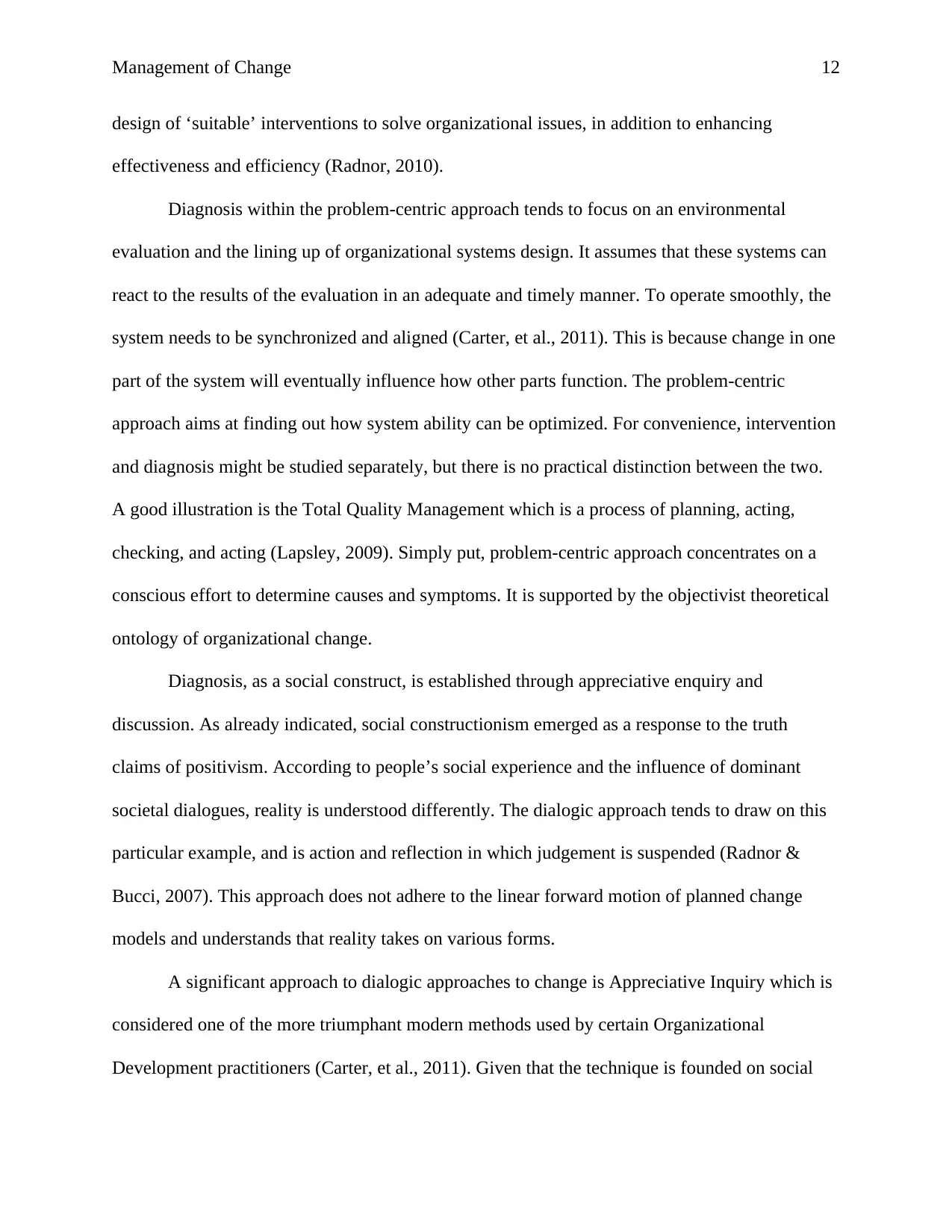
Management of Change 12
design of ‘suitable’ interventions to solve organizational issues, in addition to enhancing
effectiveness and efficiency (Radnor, 2010).
Diagnosis within the problem-centric approach tends to focus on an environmental
evaluation and the lining up of organizational systems design. It assumes that these systems can
react to the results of the evaluation in an adequate and timely manner. To operate smoothly, the
system needs to be synchronized and aligned (Carter, et al., 2011). This is because change in one
part of the system will eventually influence how other parts function. The problem-centric
approach aims at finding out how system ability can be optimized. For convenience, intervention
and diagnosis might be studied separately, but there is no practical distinction between the two.
A good illustration is the Total Quality Management which is a process of planning, acting,
checking, and acting (Lapsley, 2009). Simply put, problem-centric approach concentrates on a
conscious effort to determine causes and symptoms. It is supported by the objectivist theoretical
ontology of organizational change.
Diagnosis, as a social construct, is established through appreciative enquiry and
discussion. As already indicated, social constructionism emerged as a response to the truth
claims of positivism. According to people’s social experience and the influence of dominant
societal dialogues, reality is understood differently. The dialogic approach tends to draw on this
particular example, and is action and reflection in which judgement is suspended (Radnor &
Bucci, 2007). This approach does not adhere to the linear forward motion of planned change
models and understands that reality takes on various forms.
A significant approach to dialogic approaches to change is Appreciative Inquiry which is
considered one of the more triumphant modern methods used by certain Organizational
Development practitioners (Carter, et al., 2011). Given that the technique is founded on social
design of ‘suitable’ interventions to solve organizational issues, in addition to enhancing
effectiveness and efficiency (Radnor, 2010).
Diagnosis within the problem-centric approach tends to focus on an environmental
evaluation and the lining up of organizational systems design. It assumes that these systems can
react to the results of the evaluation in an adequate and timely manner. To operate smoothly, the
system needs to be synchronized and aligned (Carter, et al., 2011). This is because change in one
part of the system will eventually influence how other parts function. The problem-centric
approach aims at finding out how system ability can be optimized. For convenience, intervention
and diagnosis might be studied separately, but there is no practical distinction between the two.
A good illustration is the Total Quality Management which is a process of planning, acting,
checking, and acting (Lapsley, 2009). Simply put, problem-centric approach concentrates on a
conscious effort to determine causes and symptoms. It is supported by the objectivist theoretical
ontology of organizational change.
Diagnosis, as a social construct, is established through appreciative enquiry and
discussion. As already indicated, social constructionism emerged as a response to the truth
claims of positivism. According to people’s social experience and the influence of dominant
societal dialogues, reality is understood differently. The dialogic approach tends to draw on this
particular example, and is action and reflection in which judgement is suspended (Radnor &
Bucci, 2007). This approach does not adhere to the linear forward motion of planned change
models and understands that reality takes on various forms.
A significant approach to dialogic approaches to change is Appreciative Inquiry which is
considered one of the more triumphant modern methods used by certain Organizational
Development practitioners (Carter, et al., 2011). Given that the technique is founded on social
⊘ This is a preview!⊘
Do you want full access?
Subscribe today to unlock all pages.

Trusted by 1+ million students worldwide
1 out of 16
Related Documents
Your All-in-One AI-Powered Toolkit for Academic Success.
+13062052269
info@desklib.com
Available 24*7 on WhatsApp / Email
![[object Object]](/_next/static/media/star-bottom.7253800d.svg)
Unlock your academic potential
Copyright © 2020–2025 A2Z Services. All Rights Reserved. Developed and managed by ZUCOL.





